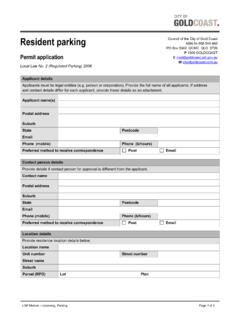Transcription of Guidelines for Dewatering Management Plan
1 1 #42025522 v4 Guidelines for Dewatering Management Plan City Development Economy Planning and Environment Directorate March 2018 #42025522 v5 Last updated 12/03/2018 Page 2 of 13 Table of Contents 1. INTRODUCTION .. 3 2. PURPOSE OF Dewatering .. 4 3. LEGISLATIVE REQUIREMENTS .. 4 4. PREPARATION OF Dewatering Management PLAN (DMP) .. 5 Dewatering release criteria .. 5 Issues to be addressed in the DMP .. 6 Treatment of groundwater .. 7 Acid sulphate soils (ASS) .. 7 Geotechnical issues .. 7 Noise and vibration issues .. 8 Odour issues .. 8 Operational and monitoring requirements .. 8 Dewatering contingency plan .. 9 Deemed to comply solution for small scale development .. 9 5. REFERENCES .. 10 Appendix A Deemed to comply checklist certification pro-forma .. 11 Appendix B Deemed to comply geotechnical certification pro-forma.
2 12 Dewatering Management plan Guidelines #42025522 v5 Last updated 12/03/2018 Page 3 of 13 1. INTRODUCTION Dewatering is defined by the process of removal of water from a site that accumulates in earthwork excavations or underneath structures at or below the existing watertable. Dewatering activities are either permanent or temporary. Permanent discharges occur from sites that have structures at or below the existing watertable, (for example, underground car parks below buildings), although this practice is being phased out. Temporary discharges occur from construction sites that have water entering the earthwork excavation. A temporary discharge usually occurs for the duration of the construction phase. This document relates specifically to temporary Dewatering activities. Construction of basements or excavation below the existing groundwater level in coastal areas has the potential to create significant sedimentation, amenity issues and other water quality impacts on sensitive estuarine and fresh water receiving environments.
3 The problem arises from the Dewatering operations associated with the basement construction. The majority of high-rise developments that incorporate basements are also located in coastal areas where the natural surface levels are below five metres Australian height datum (AHD). These areas are likely to contain actual or potential acid sulphate soils. The Dewatering required for the construction of these basements therefore often results in the extraction, through the use of groundwater spears, of low pH (acidic) groundwater. The solubility of many metals is pH sensitive and in particular the solubility of iron and aluminium increases significantly at lower pH. Because of this property, acidic groundwater often contains high concentrations of soluble metals, which are virtually colourless while in a dissolved, soluble state. While present in a soluble form at low pH, these metals are also extremely toxic to many forms of aquatic life.
4 Dewatering that may lower the watertable near a coastal or estuarine environment should be assessed for potential saltwater intrusion of the aquifer. The operator should control Dewatering to ensure there is no significant change in water quality or change in the natural watertable or flow regime of surface water. If the extracted acidic groundwater is discharged untreated to estuarine or marine receiving waters a range of possible impacts is likely to occur, including direct mortality or injury to aquatic life, reduction in the pH buffering capacity of estuaries, damage to infrastructure, and loss of visual amenity from visual plumes and staining. An assessment of the impact on local vegetation, springs, wetlands and groundwater bores used by others in the vicinity of the project should be made prior to Dewatering . Where assessment indicates potential reduction in watertable or quality of groundwater, the operator should either design the Dewatering system to overcome this threat or provide an acceptable alternative water supply to affected parties.
5 The monetary costs incurred to local authorities investigating or cleaning up when responding to the one of the abovementioned incidents can also be substantial. Odour problems that emanate from Dewatering activities can negatively impact on residents surrounding the site. If the groundwater is contaminated, gases such as hydrogen sulphide and hydrocarbon can be released during the Dewatering process. These gases when released can cause severe odours that can be offensive to nearby residents. Noise emanating from the plant such as pumps and diesel generators that is used in the Dewatering process, can cause a noise nuisance to nearby noise sensitive places. During temporary Dewatering activities in most cases the plant is required to be operated twenty four (24) hours per day, which can increase the intrusiveness of the noise particularly during later or early morning periods when the background noise levels are minimal.
6 Dewatering Management plan Guidelines #42025522 v5 Last updated 12/03/2018 Page 4 of 13 2. PURPOSE OF Dewatering The proponents/operators need to understand the environment they are working in and to evaluate potential impacts of Dewatering discharge. The proponent or operator is required to ensure that appropriate measures are taken to prevent pollution or degradation of the receiving water body. As such, discharge water should not be allowed to: enter poorly defined channels as water may leave the channel and inundate vegetation enter any surface water, (for example, ephemeral stream, creek or river) or groundwater where the physical, chemical or biological nature of the discharge will affect the beneficial use of the receiving water body cause or contribute to soil erosion have visual impact in high profile tourist or residential areas have a detrimental impact on flora and fauna downstream of the discharge point This guideline applies to Dewatering operations that draw water from groundwater seepage, excavations that intersect aquifers or run-off from storm events.
7 The main purpose is to guide the environmental Management of Dewatering associated from construction sites. 1. Prevent contaminated groundwater resulting from the Dewatering process, being discharged into the City of Gold Coast s waterways. 2. Provide for possible treatment options of groundwater prior to discharge into waterways when the quality of the groundwater requires this. 3. Protect the environmental values of the City of Gold Coast s waterways from potential/possible impacts from poor Dewatering activities. 4. Eliminate odour and noise nuisances associated with improper treatment. 3. LEGISLATIVE REQUIREMENTS Person/s conducting Dewatering activities shall do so in accordance with the requirements of the Environmental Protection Act 1994 and Environmental Protection Regulation 2008. Parts of State Planning Policy, Planning and Managing Development Involving Acid Sulphate Soils, is also applicable.
8 Person/s conducting Dewatering activities shall take all reasonable and practicable measures to: ensure all groundwater that is discharged from a site into receiving waters is adequately treated and disposed of so as not to create environmental nuisance or harm ensure all contaminated groundwater that is to be treated off-site is done so in accordance with all relevant legislation prevent the emission of nuisance odours associated with the Dewatering process ensure there is no scouring or erosion at the point of discharge into the receiving waters manage and resolve any complaints generated by the activity ensure all plant and equipment associated with the Dewatering process is to be adequately acoustically attenuated to comply with the Environmental Protection Act 1994 The Act provides that all persons have a general environmental duty to take all practical and reasonable measures to prevent or
9 Minimise harm when carrying out activities. Person/s carrying out Dewatering activities shall take all reasonable and practical measures to ensure: Dewatering wastewater is treated to meet requirements and is discharged or disposed in a way that does not cause environmental harm or environmental nuisance all groundwater treated off-site or unable to be treated is done so in accordance with relevant legislation no scouring or erosion at the point of discharge into the receiving waters no offensive odours or nuisance noise are released as a result of Dewatering Dewatering Management plan Guidelines #42025522 v5 Last updated 12/03/2018 Page 5 of 13 4. PREPARATION OF Dewatering Management PLAN (DMP) The DMP will be submitted with the development application and must include details of who is carrying out the Dewatering activities, who the developer is, and who the owner is.
10 It will also state clearly where to address complaints or issues that may arise during Dewatering activities. For Council of the City of Gold Coast s assessment and approval, the applicant must provide the following information in the DMP. 1. Purpose of Dewatering (that is, an explanation of why Dewatering is necessary). 2. Dewatering technique (that is, wellpoint, deep well, open hole, etc.). 3. Anticipated Dewatering flow rate and total Dewatering duration. 4. Controls (that is, settling tank, turbidity curtain, etc.) and method of effluent discharge. 5. Measures and techniques to manage noise, vibration and odour issues. 6. Measures and techniques to manage geotechnical stability issues. 7. Contingency plan in case of any emergency situation. 8. If Dewatering conducted in a contaminated area, engineering specifications for Dewatering effluent treatment (that is, air-stripper, carbon filtration, etc.)







